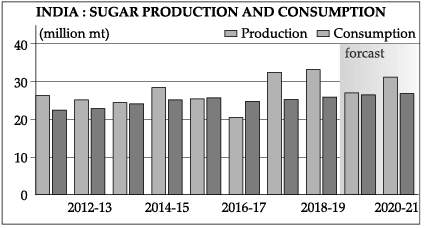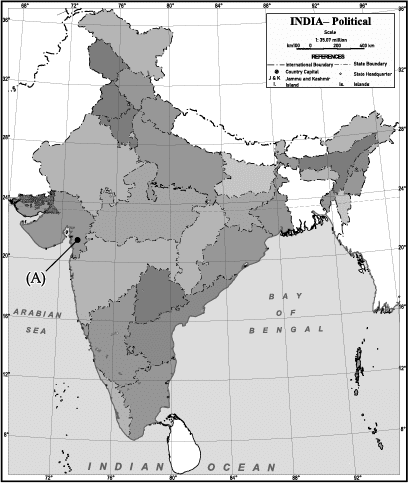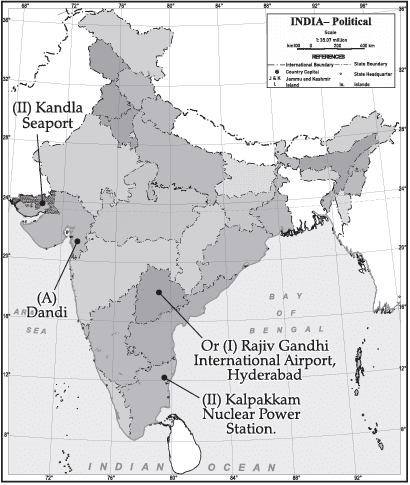Class 10 Social Science: CBSE Sample Question Paper- Term II (2021-22) - 2 | Social Studies (SST) Class 10 PDF Download
| Table of contents |

|
| Class-X |

|
| Time: 120 |

|
| Minutes |

|
| M.M: 40 |

|
| Section - A |

|
| Section - B |

|
| Section - C |

|
| Section - D |

|
| Section - E |

|
Class-X
Time: 120
Minutes
M.M: 40
General Instructions:
Read the following instructions very carefully and strictly follow them:
- This Question paper is divided into five sections-Section A, B, C, D and E.
- All questions are compulsory.
- Section-A: Question no. 1 to 5 are very Short Answer type questions of 2 marks each. Answer to each question should not exceed 40 words.
- Section-B: Question no. 6 to 8 are Short Answer type questions, carrying 3 marks each. Answer to each question should not exceed 80 words.
- Section-C: Question no. 9 and 10 are long Answer type questions, carrying 5 marks each. Answer to each question should not exceed 120 words.
- Section-D: Question no. 11 and 12 are Case Based questions.
- Section-E: Question no. 13 is map based, carrying 3 marks with two parts, 13.1 from History (1 mark) and 13.2 from Geography (2 marks).
- There is no overall choice in the question paper. However, an internal choice has been provided in a few questions. Only one of the choices in such questions have to be attempted.
- In addition to this, separate instructions are given with each section and question, wherever necessary.
Section - A
Q.1. Explain any three effects of the ‘Non-Cooperation Movement’ on the economic front.
Three effects of the ’Non-Cooperation Movement’:
(i) Foreign goods were boycotted at a large scale.
(ii) Liquor shops picketed and foreign clothes burnt in huge.
(iii) Import of Foreign cloth and goods was reduced to half.
(iv) In many places Merchants and Traders refused to trade in Foreign goods or finance foreign trade.
Q.2. Distinguish between integrated steel plants and mini steel plants, stating two points of distinction.
Differences between mini steel plant and integrated steel:
(i) An integrated steel plant is larger than a mini steel plant.
(ii) Mini steel plant uses steel scrap and sponge iron while integrated steel plant uses basic raw materials, i.e., iron ore for making steel.
(iii) Mini steel plant produces mild and alloy steel while integrated steel plant produces only steel.
Q.3. State any two conditions as laid down by the Election Commission to recognize a ‘State Party ’ and ‘National Party’.
The conditions as laid down by the Election Commission to recognize a ‘State Party ’ and ‘National Party’ are as follows:
(i) In a State Party, the party members aim to highlight regional interests. On the other hand, a National Party gives due importance to national interests.
(ii) A State Party can contest in elections only in a particular state, whereas a National Party can contest in elections all across the country.
(iii) Example: BJP and Congress are National Parties, whereas Akali Dal and Trinamool Congress are State-level Parties.
Q.4. ’‘The rupee is widely accepted as a medium of exchange.’’ Explain.
The rupee is widely accepted as a medium of exchange because of the following reasons:
(i) In India, the Reserve Bank of India issues currency notes on behalf of the Central government and as per law no other individual or organisation is allowed to issue currency.
(ii) The law legalises, the use of rupee as a medium of payment that cannot be refused in settling transactions in India, which means no individual in India can legally refuse a payment made in rupees.
Q.5. Read the data in the chart or diagram given below and answer the questions that follows:
(5.1) Compare the 2012-2013 and 2018-2019 data and give any one reason for why are Sugar Mills are concentrated in sugarcane producing areas?
(5.2) Write any one problems faced by Sugar Industry in India?
(5.1) Sugar industries are concentrated in the sugarcane producing areas because:
(i) The raw material used in the Sugar Mills, is sugarcane which is bulky.
(ii) In haulage, its sucrose content reduces.
(5.2) Challenges faced by sugar industry in India
(i) Seasonal nature of the industry.
(ii) Old and inefficient methods of production.
(iii) Transport delays for sugarcane to reach to the mills.
(iv) Need to maximize the use of bagasse.
Section - B
Q.6. Why did Europeans flee to America in the nineteenth century. Explain.
Europeans fled to America in the 19th Century because:
(i) Until the 19th Century, poverty and hunger were common in Europe.
(ii) Cities were crowded and deadly diseases were widespread.
(iii) Religious conflicts were common and religious dissenters were persecuted.
(iv) Scrapping of Corn Laws, led to inability of British agriculture to compete with imports.
(v) Thousands of people were left unemployed due to agricultural land lying uncultivated. So, people migrated in thousands, crossed oceans to find employment and a better future.
(vi) In America, plantations were growing cotton and sugar for the European market. These plantations were worked on by slaves.
Q.7. Why has political funding become a threat for Democracy?
Political Funding has became a threat for Democracy due to the following reasons:
(i) Since parties are focused only on winning elections they tend to use short-cuts and nominate these candidates who have or can raise lots of money. This in twin means lack of experienced and comparatively more suitable candidates in the party.
(ii) Rich people and companies who give funds to the parties tend to have influence on the policies and decisions made by the party.
(iii) As most political parties are dependent on money from rich people and companies, the poor and middle classes do not agree to participate in the electoral process. Hence a majority of people keep away from politics and have little voice in it.
Q.8. How can the benefits of Globalisation be shared better? Explain.
OR
Explain any three loan activities of banks in India.
The benefits of Globalisation can be shared better in the following ways:
(i) The government policy must protect the interest, not only of the rich and the powerful, but of all the people in the country.
(ii) The government can ensure that labour laws are properly implemented and workers get their rights.
(iii) It can support small producers to improve their performance till they become strong enough to compete.
(iv) It can use trade and investment barriers.
(v) It can negotiate at the WTO for ‘fairer rules’.
OR
Loan activities of Banks in India:
(i) Banks use the major portion of the deposits to extend loans.
(ii) Banks make use of the deposits to meet the loan requirements of the people.
(iii) Banks mediate between those who have surplus funds (the depositors) and those who are in need of these funds (the borrowers).
(iv) Banks charge a higher interest rate on loans than what it offers on deposits.
Section - C
Q.9. Democracy ’s ability to generate its own support is itself an outcome that cannot be ignored.’ Support the statement with examples.
OR
‘There is an overwhelming support for the idea of democracy in South Asia.’ Support the statement with examples.
(i) Democracy ensures that decision making is based on norms and procedure.
(ii) Every citizen has the right and means to examine the process of decision making.
(iii) Democratic Governments are accountable, legitimate and transparent governments.
(iv) People have the right to choose their rulers.
(v) Democracy gives its citizens the right to information about the government and its functioning.
(vi) A Democratic Government is the people’s own government and it is run by the people.
(vii) Any other relevant point.
OR
(i) Democratic Government is people's own government.
(ii) Countries from South Asia want democratic rights for people.
(iii) Countries want to elect their representatives by themselves.
(iv) Democracy provides dignity and freedom to its citizens.
(v) Democracy accommodates social diversity.
(vi) Democracy is based on the idea of discussion and negotiation.
(vi) E.g., India, Nepal, Bangladesh, Sri Lanka, Pakistan
(vii) Any other relevant point.
Q.10. Examine the role of Information Technology in stimulating the process of globalization.
OR
Assess the impact of globalization on India and its people.
(i) Technology has been changing rapidly.
(ii) Telecommunication facilities (telegraph, telephone including mobile phones, fax) are used to contact and access information.
(iii) Helps to communicate from remote areas.
(iv) Development of satellite communication devices.
(v) Computers have now entered almost every field of activity.
(vi) One can obtain and share information through internet.
(vii) Electronic mail (e-mail) and talk (voice-mail) across the world at negligible costs
(viii) Has played a major role in spreading out production of services across countries
(ix) Any other relevant point.
OR
(i) Globalization has resulted in more choices for the consumers.
(ii) This has improved the standard of living of people.
(iii) MNCs have increased their investments in industries such as cell-phones, automobiles, electronics, soft drinks, etc.
(iv) New jobs have been created.
(v) Some local companies that supply raw materials to MNCs have also benefited.
(vi) Some local companies have been able to invest in newer technology and production methods.
(vii) Globalisation has enabled some large companies such as Tata Motors, Infosys to emerge as multinational companies.
(viii) Companies providing services have also benefited by globalisation.
(ix) Flexibility in labour laws.
(x) Expansion of unorganised sector.
(xi) Stiff competition to the local producers.
(xii) Any other relevant point.
Section - D
Q.11. Read the given text and answer the following questions:
The Movement started with middle-class participation in the cities. Thousands of students left Government controlled schools and colleges, headmasters and teachers resigned, and lawyers gave up their legal practices. The Council Elections were boycotted in most provinces except Madras, where the Justice Party, the party of the non- Brahmans, felt that entering the council was one way of gaining some power-something that usually only Brahmans had access to.
The effects of Non-Cooperation on the economic front were more dramatic. Foreign goods were boycotted, liquor shops picketed and foreign cloth burnt in huge bonfires. The import of foreign cloth halved between 1921 and 1922, its value dropping from ₹ 102 crore to ₹ 57 crore. In many places merchants and traders refused to trade in Foreign goods or finance foreign trade. As the boycott movement spread, and people began discarding imported clothes and wearing only Indian ones, production of Indian Textile Mills and handlooms went up.
But this Movement in the cities gradually slowed down for a variety of reasons. Khadi cloth was often more expensive than mass produced mill cloth and poor people could not afford to buy it. How then could they boycott mill cloth for too long? Similarly, the boycott of British institutions posed a problem.
For the movement to be successful, alternative Indian institutions had to be set up so that they could be used in place of the British ones. These were slow to come up. So students and teachers began trickling back to government schools and lawyers joined back work in Government Courts.
(11.1) What was the purpose of Justice Party to contest Elections to the Council in Madras?
(11.2) How was the effect of ‘Non-Cooperation on the economic front’ dramatic?
(11.3) Why the import of Foreign cloth between 1921 and 1922 saw changes?
(11.1) The purpose of the Justice Party to contest Elections to the Council in Madras are to contest elections to the Council as it was one of the ways to gain some power that usually only Brahmans had access to.
(11.2) Merchants refused to trade in foreign goods or finance foreign trade.
(11.3) The import of Foreign cloth between 1921 and 1922 saw changes because the import of foreign cloth halved between 1921 and 1922.
Q.12. Read the given text and answer the following questions:
Manufacturing industries not only help in modernising agriculture, which forms the backbone of our economy, they also reduce the heavy dependence of people on agricultural income by providing them jobs in secondary and tertiary sectors. Industrial development is a precondition for eradication of unemployment and poverty from our country. This was the main philosophy behind public sector industries and joint sector ventures in India. It was also aimed at bringing down regional disparities by establishing industries in tribal and backward areas. Export of manufactured goods expands trade and commerce, and brings in much needed foreign exchange. Countries that transform their raw materials into a wide variety of finished goods of higher value are prosperous. India’s prosperity lies in increasing and diversifying its manufacturing industries as quickly as possible. Agriculture and industry are not exclusive of each other. They move hand in hand. For instance, the agro industries in India have given a major boost to agriculture by raising its productivity.
(12.1) What is the importance of manufacturing industries?
(12.2) Research and Development and Banking fall on which sector?
(12.3) What a country needs to develop to attract foreign manufacturing firms?
(12.1) Agriculture is Primary Sector, whereas Manufacturing Industries are the Secondary Sector. They not only help on modernizing agriculture but also reduce the heavy dependence of people on agriculture income by providing them jobs also in secondary and Tertiary sectors.
(12.2) Research and Development and Banking fall on Tertiary and Quaternary sector respectively.
(12.3) To attract foreign manufacturing firms, a country needs to develop Infrastructure facilities.
Section - E
Q.13. (13.1) On the given outline Political Map of India, identify the place marked as A with the help of following information and write its correct name on the line marked near it.
(A) The place where Civil Disobedience Movement was started.
(13.2) On the same given map of India, locate the following:
(I) Kalpakkam Nuclear Power Station.
OR
Rajiv Gandhi International Airport.
(II) Kandla major seaport
(13.1) (A) Dandi
(13.2)
|
95 videos|815 docs|79 tests
|





















